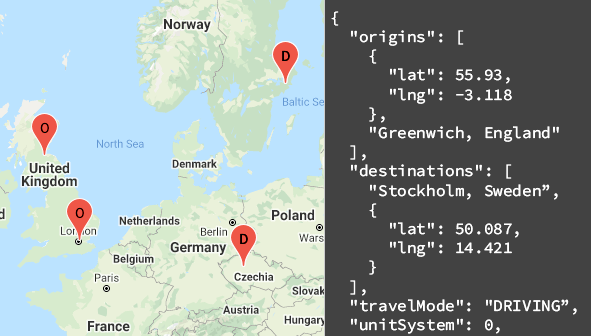مقدمه
API ماتریس فاصله (Legacy) سرویسی است که یک درخواست HTTPS حاوی مبدا و مقصد را برای یک روش حمل و نقل مشخص میپذیرد. برای هر ترکیبی از مبدا و مقصد، مسافت و مدت زمان سفر را برمیگرداند.
چرا از API ماتریس فاصله استفاده کنیم؟
شما میتوانید از API ماتریس فاصله برای تعیین کارآمدترین مسیرهای سفر بین چندین مبدا و مقصد ممکن استفاده کنید. به عنوان مثال، کدام کارگران را به محلهای کار بفرستید یا از کدام انبارها بستهها را ارسال کنید.
کارهایی که میتوانید با API ماتریس فاصله انجام دهید
با استفاده از API ماتریس مسافت، میتوانید مسافت و زمان سفر را برای ماتریسی از مبدا و مقصد ارائه دهید. میتوانید چندین گزینه از جمله روش حمل و نقل مانند رانندگی، دوچرخهسواری، حمل و نقل عمومی یا پیادهروی و همچنین روشهای حمل و نقل عمومی مانند اتوبوس، مترو، قطار، تراموا یا راهآهن را مشخص کنید.
API مربوط به Distance Matrix اطلاعاتی را بر اساس مسیر پیشنهادی بین نقاط شروع و پایان ارائه میدهد. میتوانید این نوع دادههای فاصله را درخواست کنید:
- مسافت برای حالت سفر انتخاب شده
- مسافت به کیلومتر یا مایل
- زمان تخمینی سفر در ترافیک

نحوه عملکرد API ماتریس فاصله
API ماتریس فاصله از هر تعداد مبدا (نقاط شروع) و مقصد استفاده میکند و مسافت و زمان سفر بین هر مبدا و تمام مقاصد درخواستی را برمیگرداند، که از اولین مبدا در درخواست شروع شده و گام به گام به سمت بعدی ادامه مییابد.
برای مثال، اگر درخواست شما A و B را به عنوان مبدا و C و D را به عنوان مقصد مشخص کند، مسافت و زمان سفر را به این ترتیب برمیگرداند:
- الف تا ج
- الف تا د
- ب تا ج
- ب تا د
مثال زیر درخواستی برای دو مبدا نشان میدهد: واشنگتن دی سی و بوستون، با یک مقصد واحد، نیویورک سیتی، نیویورک، در قالب JSON:
https://maps.googleapis.com/maps/api/distancematrix/json ?destinations=New%20York%20City%2C%20NY &origins=Washington%2C%20DC%7CBoston &units=imperial &key=YOUR_API_KEY
منابع
جدول زیر منابع موجود از طریق API Distance Matrix را به همراه دادههایی که برمیگرداند، خلاصه میکند.
| منابع داده | دادهها بازگردانده شدند | قالب بازگشتی |
|---|---|---|
| ماتریس فاصله مبدا و مقصد را به صورت شناسه مکان، آدرس یا مختصات طول و عرض جغرافیایی ارائه دهید. |
|
|
نحوه استفاده از API ماتریس فاصله
| ۱ | راهاندازی شوید | با راهاندازی پروژه Google Cloud خود شروع کنید و دستورالعملهای راهاندازی که در ادامه آمده است را تکمیل کنید. |
| ۲ | درخواست ماتریس فاصله را امتحان کنید | زمانی که کلید API را داشته باشید، میتوانید مستقیماً از مرورگر خود، آزمایش API مربوط به Distance Matrix را شروع کنید. برای مثالها، به نمونه درخواستها در راهنمای شروع به کار مراجعه کنید. |
| ۳ | نوشتن یک درخواست پیچیدهتر | درخواستی را امتحان کنید که چندین مبدا و مقصد را ارائه میدهد. درباره پارامترهای اختیاری برای محدود کردن محاسبات، مانند زمان حرکت مشخص یا محدودیتهای مسیر، اطلاعات کسب کنید. به پارامترهای اختیاری در راهنمای درخواست و پاسخ ماتریس فاصله مراجعه کنید. |
| ۴ | اصول اولیه پاسخ را درک کنید | پاسخهای داده را بررسی کنید تا برای استفاده از دادههای ماتریس فاصله در برنامه خود آماده شوید. برای جزئیات بیشتر به پاسخهای ماتریس فاصله مراجعه کنید. |
| ۵ | دادههای ماتریس فاصله را در برنامه خودتان بگنجانید! | با استفاده از این دادهها میتوانید مسافت و زمان سفر را محاسبه کنید. |
کتابخانههای کلاینت موجود
این API را به زبان دلخواه خود از طریق یکی از کتابخانههای کلاینت زیر فراخوانی کنید:
- کلاینت جاوا برای سرویسهای نقشه گوگل
- کلاینت پایتون برای سرویسهای نقشه گوگل
- کلاینت Go برای سرویسهای نقشه گوگل
- کلاینت Node.js برای سرویسهای نقشه گوگل
کلاینت جاوا، کلاینت پایتون، کلاینت گو و کلاینت نود.جیاس برای سرویسهای نقشههای گوگل، کتابخانههای کلاینتی هستند که توسط جامعه پشتیبانی میشوند و تحت مجوز آپاچی ۲.۰ متنباز میباشند. آنها را از گیتهاب دانلود کنید، جایی که میتوانید دستورالعملهای نصب و نمونه کد را نیز پیدا کنید.
قدم بعدی چیست؟
- شروع استفاده از ماتریس فاصله : به «شروع» بروید.
- با نمونه درخواستها و پاسخها شروع کنید : به درخواست و پاسخ ماتریس فاصله بروید.
- از بهترین شیوهها پیروی کنید : به بهترین شیوههای سرویس وب بروید.

